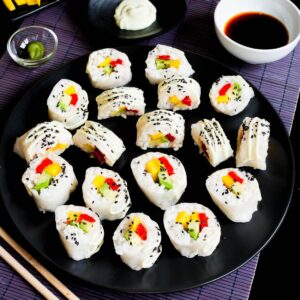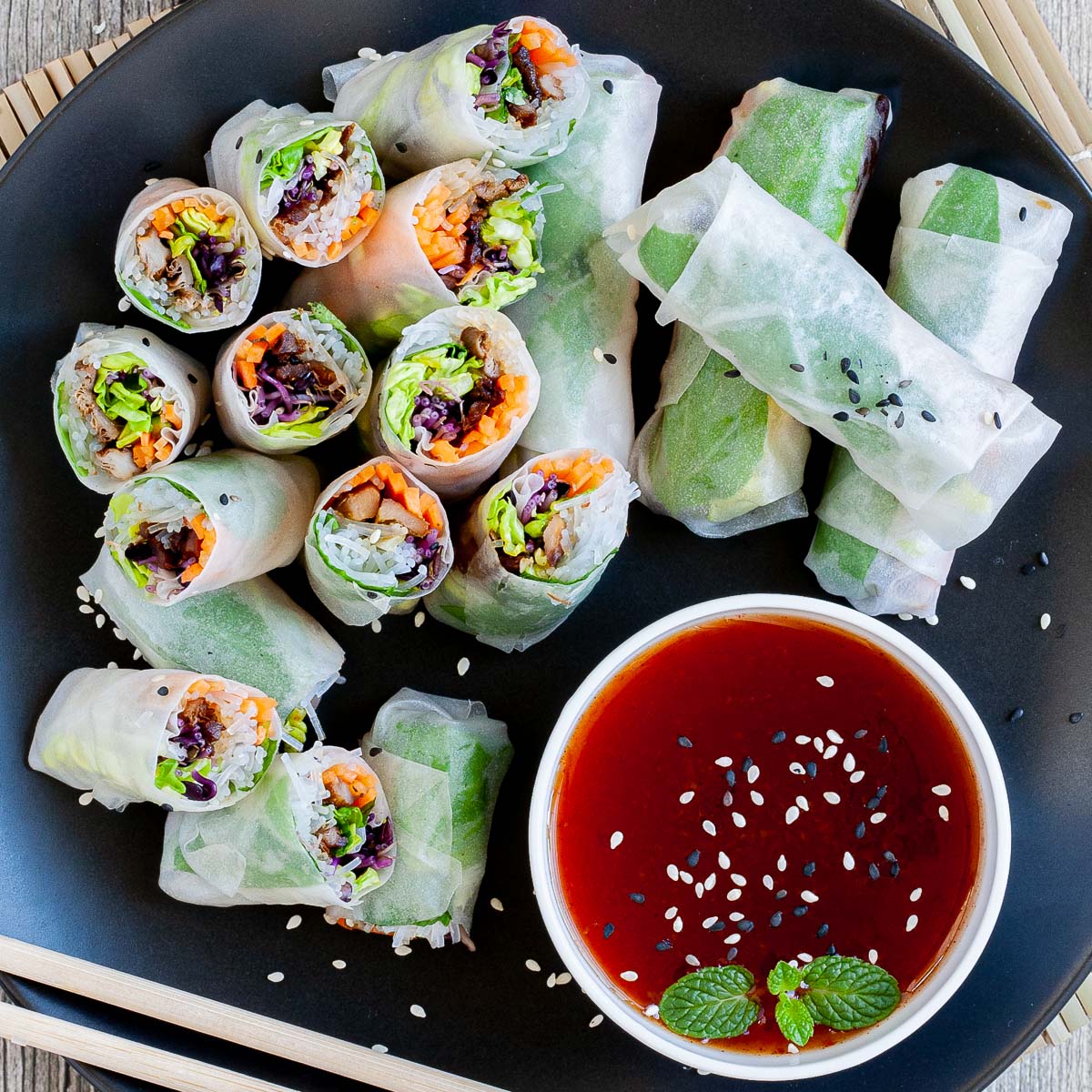Rice Paper Sushi without Seaweed
This rice paper sushi without seaweed is a refreshing twist on traditional sushi. It is filled with mango, avocado, and roasted red pepper slices, then drizzled with creamy wasabi mayonnaise and sprinkled with black sesame seeds. If you are...

By Nandor Barta on 09/26/2024 - May contain affiliate links. Please read our disclosure.
This rice paper sushi without seaweed is a refreshing twist on traditional sushi. It is filled with mango, avocado, and roasted red pepper slices, then drizzled with creamy wasabi mayonnaise and sprinkled with black sesame seeds.

Want to save this post?
Enter your email below and get it sent straight to your inbox. Plus, I’ll send you budget recipes and money-saving tips every week!
If you are looking for a recipe without strong fishy flavors, this sushi without nori may just be perfect for you. I love how the rice paper brings a light and delicate texture to the sushi, making it perfect for a light snack or appetizer.
Looking for more recipes using rice paper wrappers? Then check out my rice paper spring rolls and rice paper dumplings.
Jump to:❤️ Why you’ll love it🧾 Key ingredients🥘 Equipment👩🍳 Instructions💡 Expert tip🔄 Variations🥣 Serving ideas❄️ Storing tips🤔 FAQsMore rice paper recipesRice Paper Sushi without Seaweed❤️ Why you’ll love it
I absolutely love how this recipe gives a fun and delicious twist to traditional sushi by using rice paper instead of seaweed. The result is a light and fresh sushi roll with a mild, slightly chewy texture from the rice paper that is just so good.
The combination of creamy avocado, sweet mango, and smoky roasted red pepper not only adds a beautiful pop of color to the rolls but also a variety of flavors and textures that work so well together.
Plus, the use of rice paper wrappers not only makes this recipe unique but also a great option for anyone who may not be a fan of the strong, fishy flavor of nori sheets.
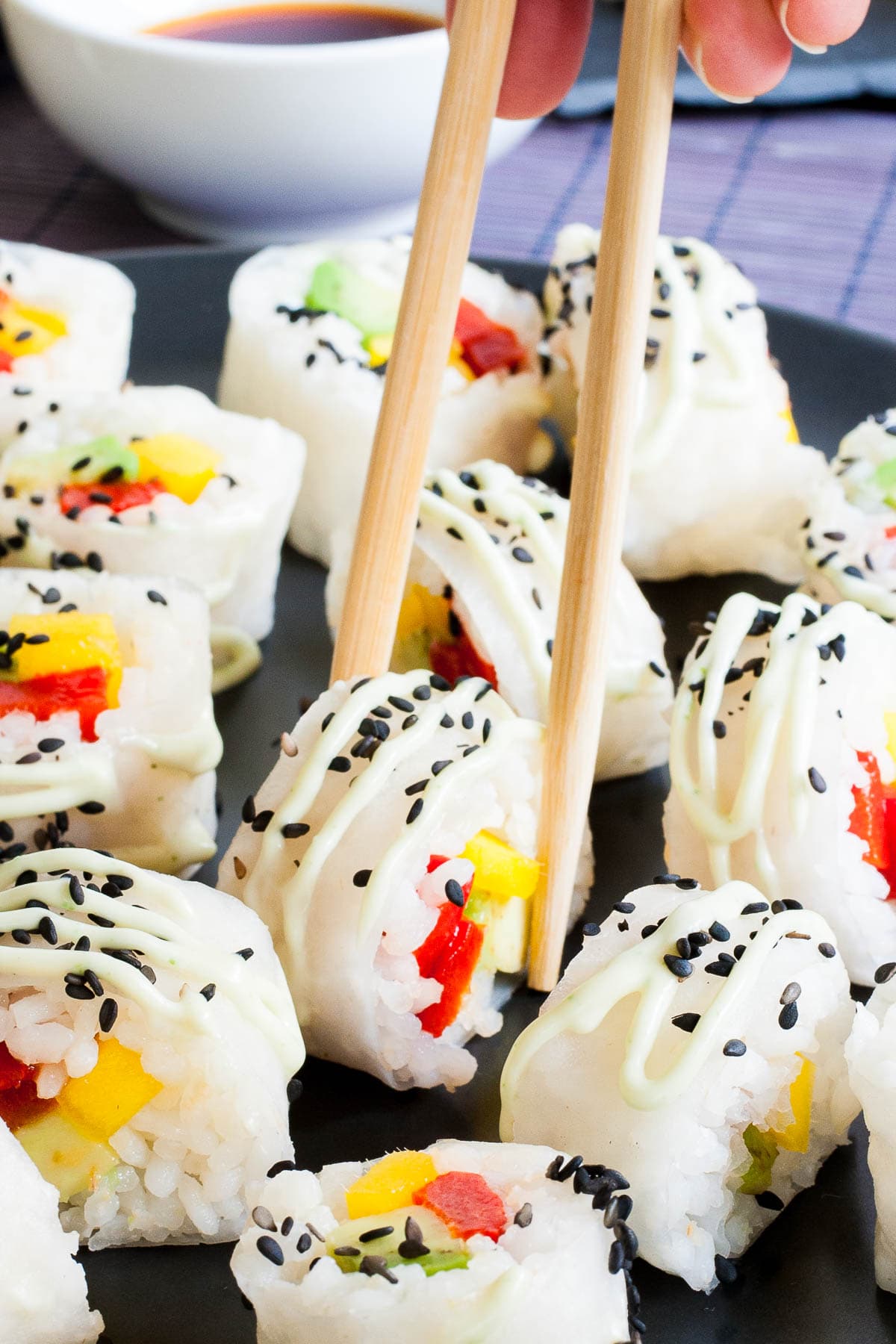
🧾 Key ingredients
This recipe is a beautiful twist on traditional sushi, using simple ingredients that you can find at your local grocery store. Here are the key ingredients you will need:
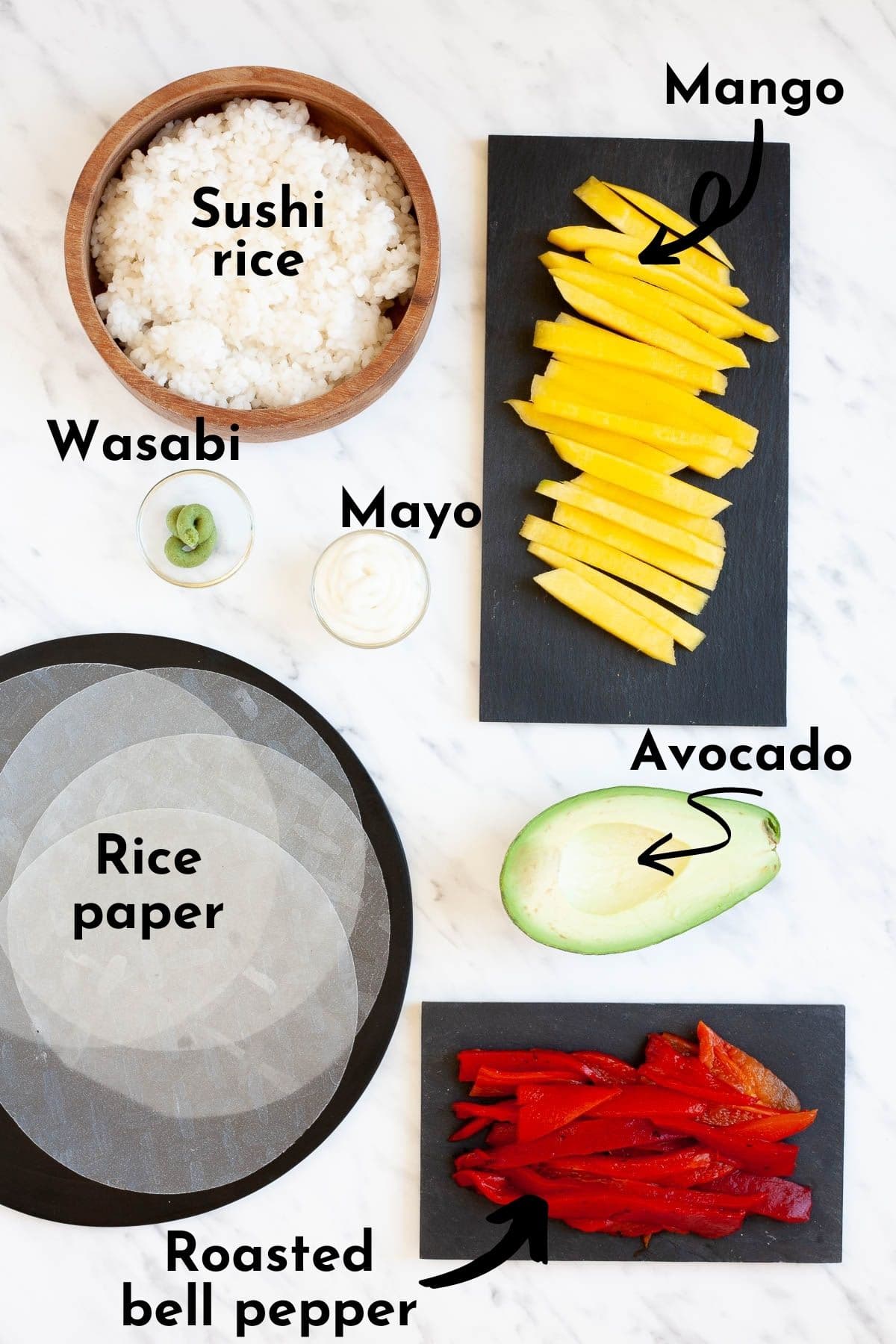
Rice vinegar is a key ingredient in sushi rice, giving it the distinct sweet and tangy flavor that pairs well with the other ingredients. You can find rice vinegar in the Asian section of your grocery store.
Avocado and mango are the stars of this sushi, adding a creamy, sweet flavor and a pop of color.
Roasted red pepper is a unique addition to this sushi, adding a sweet and smoky flavor that compliments the other ingredients well.
Rice paper sheets are used to wrap the sushi, giving it a light and delicate texture that is different from traditional norimaki. You can find rice paper sheets in the Asian section of your grocery store.
Wasabi and mayo are used as optional condiments, adding an extra kick of flavor to the sushi. You can find wasabi in the Asian section of your grocery store. For a vegan version, you can use vegan mayo.
Black sesame seeds are used as a garnish, adding a pop of color and a nutty flavor to the sushi. You can find black sesame seeds in the spice aisle of your grocery store.
Pickled ginger is a traditional accompaniment to sushi, adding a sweet and tangy flavor that helps cleanse the palette between bites. You can find pickled ginger in the Asian section of your grocery store.
🛒 You can find detailed measurements for all ingredients in the printable version of the recipe card at the bottom of this post.
🥘 Equipment
To make this unique and delicious rice paper sushi, the most important piece of equipment you will need is a good quality sharp knife. As you will be rolling the sushi without a bamboo mat, a sharp knife will ensure that you can neatly and precisely cut your rolls into perfect, bite-sized pieces.
👩🍳 Instructions
Preparing the ingredients
STEP 1
Begin by rinsing your sushi rice under cold water using a fine mesh sieve. Then, in a pot, pour in fresh cold water and rice vinegar. Add the rinsed rice and salt to this pot.
STEP 2
Once the ingredients are in the pot, bring it to a boil. When it starts boiling, turn the heat low and simmer until the water disappears. Then, remove it from the heat and cover it with a lid. Let it stay covered for 5 minutes. Your sushi rice is now ready.
STEP 3
Next, prepare your fillings. Slice your roasted red peppers, mango, and avocado. These will be the fillings for your sushi rolls.
Making the rice paper sushi
STEP 1
Take two rice papers with a diameter of 6 inches (approximately 16 cm) and gently submerge them in lukewarm water, one at a time. After they are submerged, transfer them to a dry and smooth surface, partly covering each other.
STEP 2
Now, scoop some of the cooked sushi rice in the middle of the rice paper, leaving the edges free.
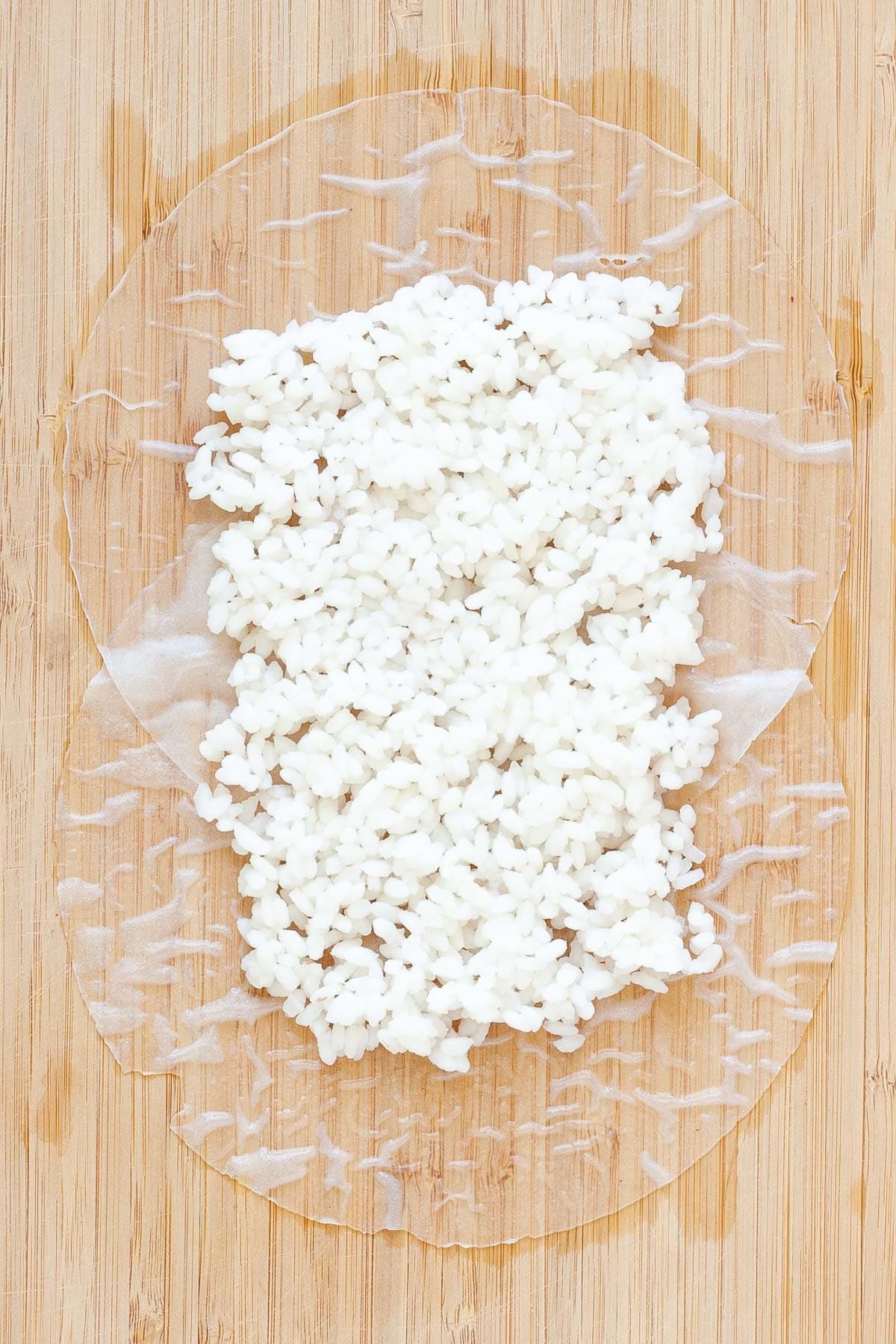
STEP 3
Then, place a couple of slices of roasted red pepper, mango, and avocado on top of the rice.
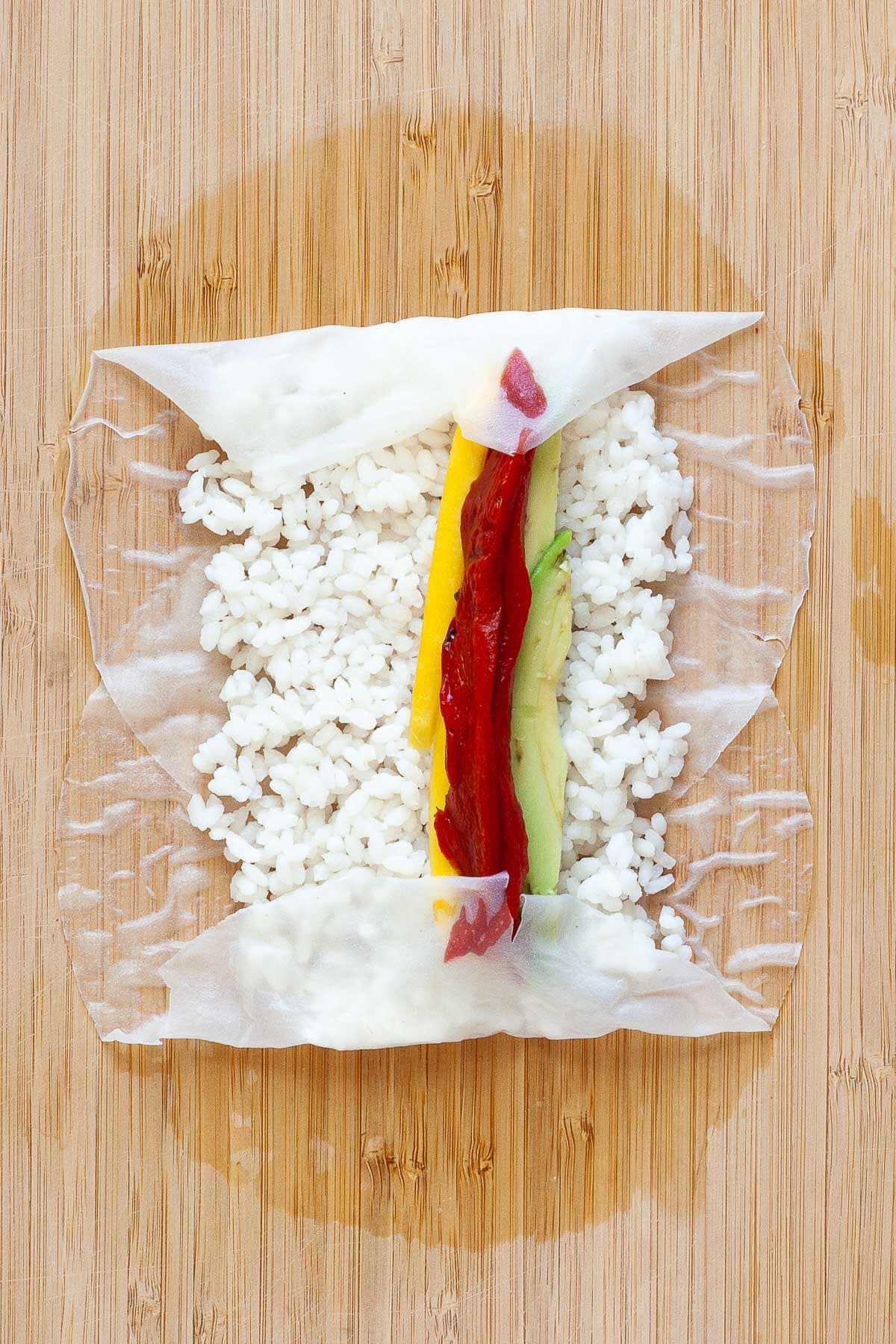
STEP 4
Fold the sides of the rice paper towards the middle.
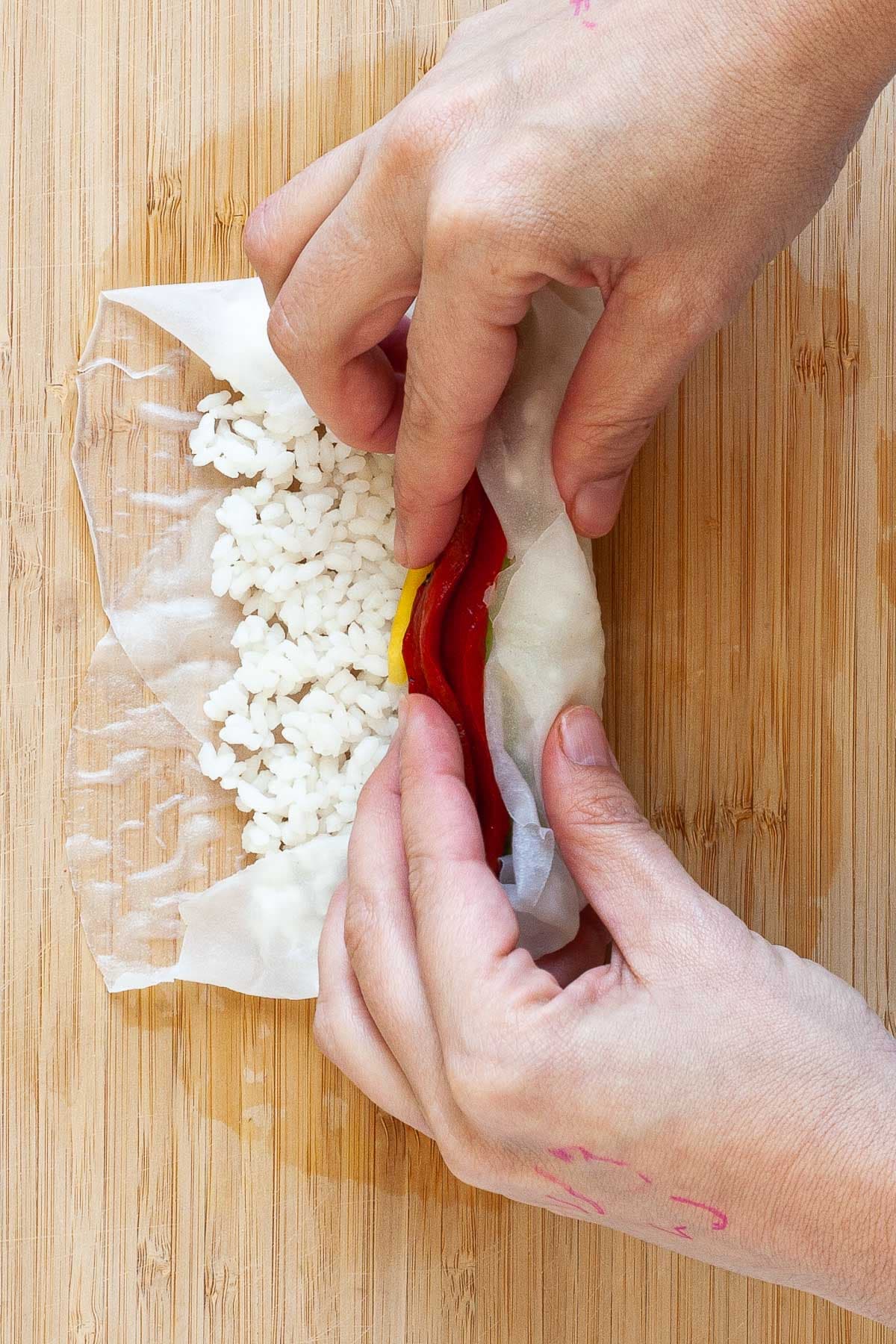
STEP 5
Then, roll them up from the bottom to the top as tight as you can. This will be your sushi roll. Repeat this process for the remaining rice papers.
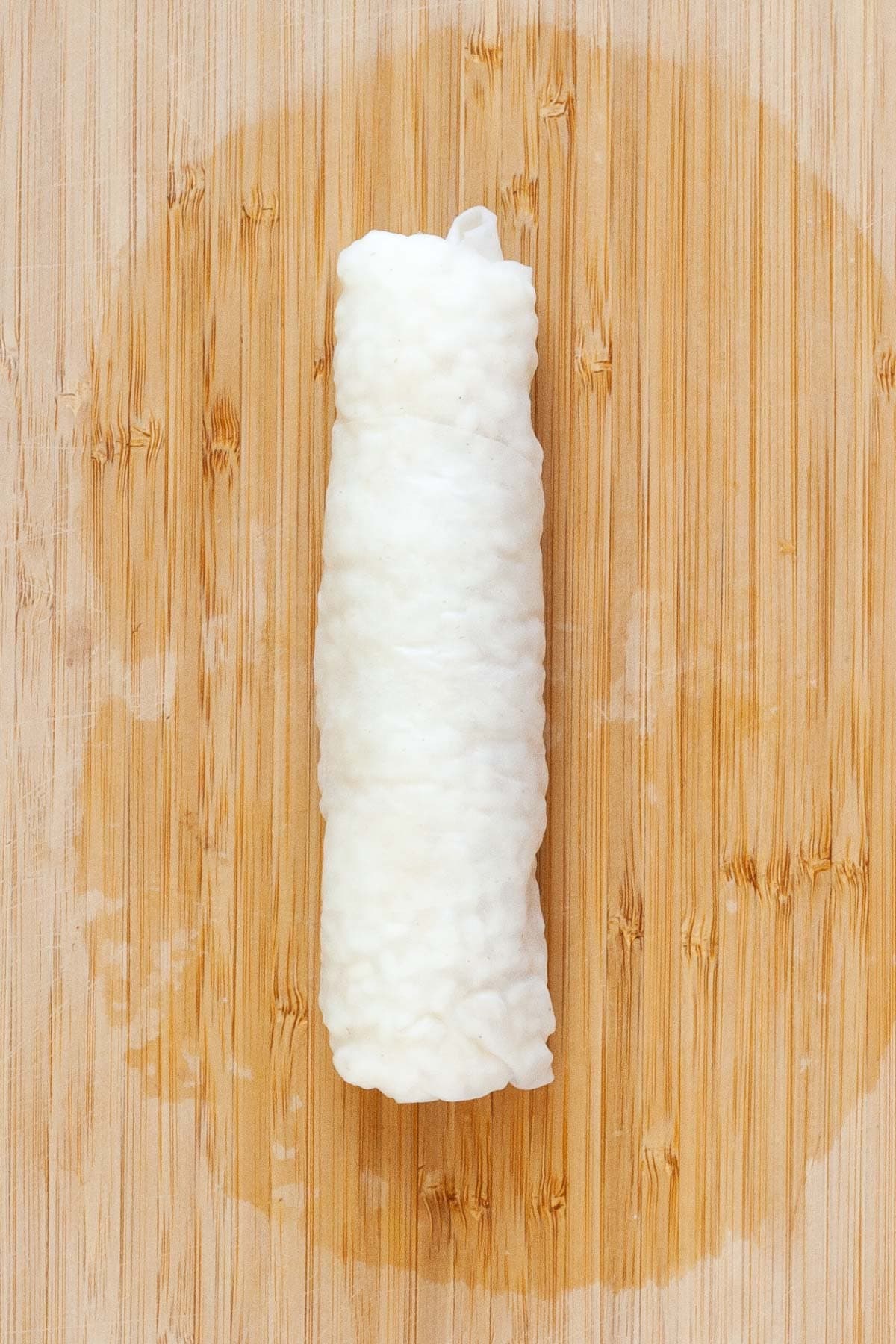
STEP 6
Finally, drizzle your sushi rolls with wasabi mayo and sprinkle some black sesame seeds on top. Cut the rolls into 5-6 pieces using a sharp knife. Your rice paper sushi without seaweed is ready to be enjoyed.
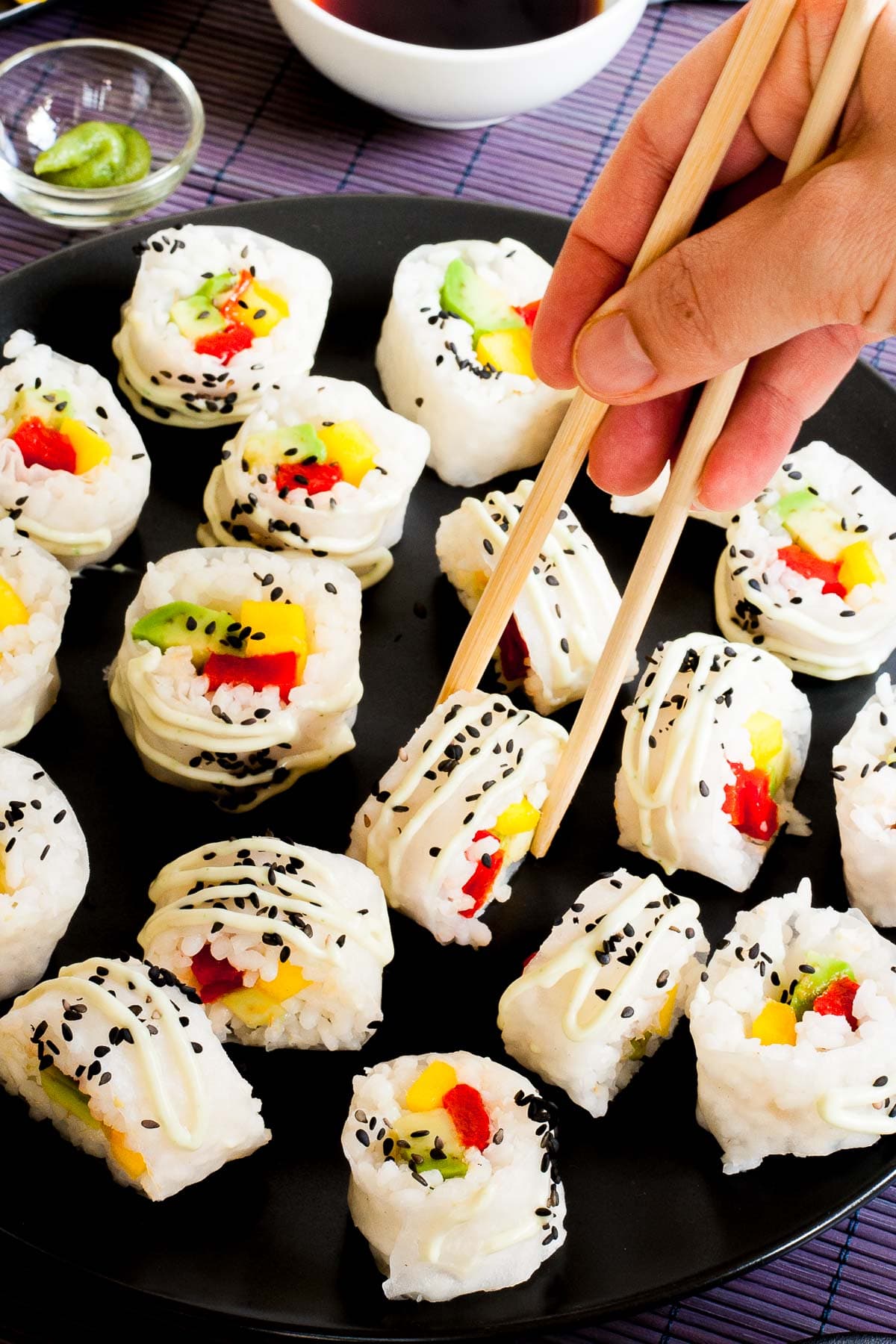
💡 Expert tip
The key to this recipe is the preparation of the rice paper. It is crucial to remember to use dry hands when handling the rice paper sheets. Wet hands can activate the rice paper, causing it to stick together or become too soft, making it difficult to work with.
🔄 Variations
If you are a fan of a little heat in your food, consider adding some chili oil to your sushi rolls. This will give them a spicy twist and add a unique flavor that complements the sweetness of the mango and the creaminess of the avocado.
If you are looking for a more traditional sushi flavor, you can incorporate some Japanese-inspired ingredients. Try adding some Japanese mushrooms like shiitake or oyster mushrooms. These will bring a rich, umami flavor to your rolls and are a great way to add some variety to your sushi.
If you want to add some protein to your sushi rolls, consider incorporating tofu. It is a great source of plant-based protein and has a mild flavor that will pair well with the other ingredients. You can either sauté the tofu with some soy sauce and sesame oil or use it in its plain form for a different texture.
Try any of the fillings from my other sushi recipes: sweet potato sushi rolls, sushi without fish, or smoked tofu sushi.
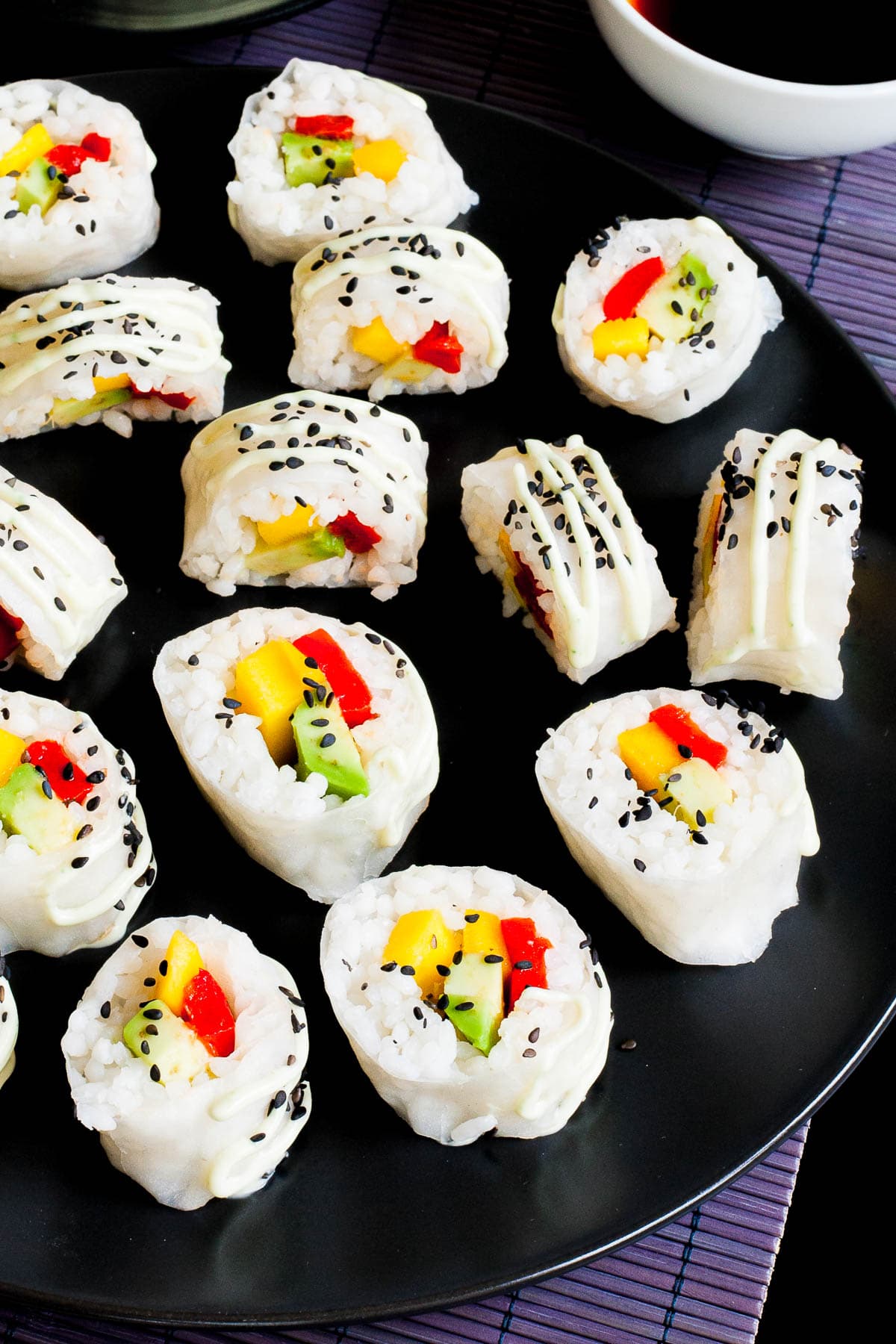
🥣 Serving ideas
This rice paper sushi without seaweed is a versatile and delicious dish that can be enjoyed in a variety of ways. It makes for a perfect appetizer or snack, and it can also be served as a main course.
I love to serve it with a side of pickled ginger and a drizzle of soy sauce or tamari for a traditional sushi flavor. It is also great with some hot mustard or chili oil for an extra kick of heat.
If you are looking for a refreshing and light meal, these sushi rolls can be served with a side of seaweed salad or a cucumber salad.
They are also a great addition to a sushi platter, along with some traditional seaweed-wrapped sushi rolls and some veggie tempura.
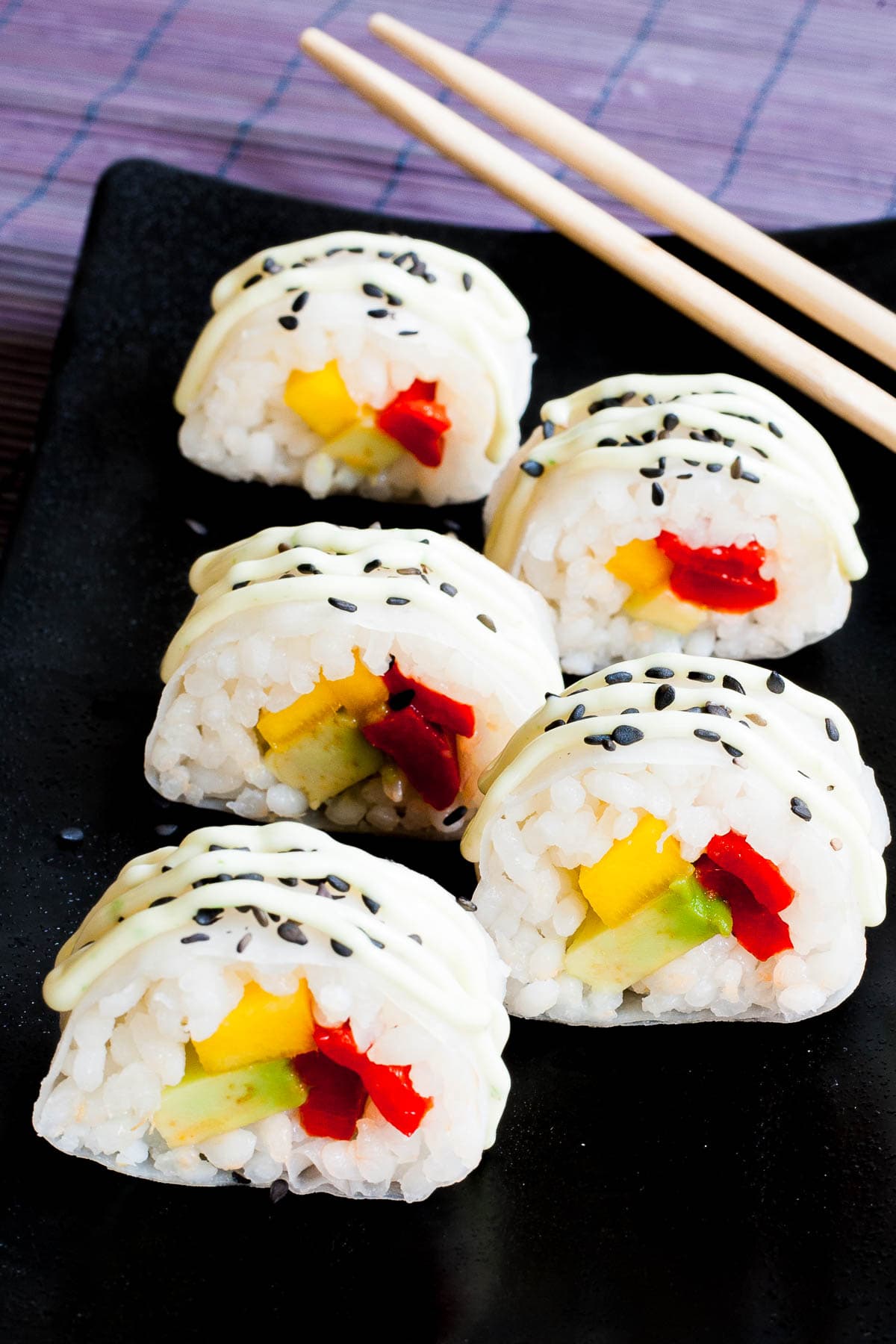
❄️ Storing tips
Storing and reheating rice paper sushi rolls is a bit tricky due to the delicate nature of the rice paper. However, it is still possible to enjoy the leftovers the next day.
To store the leftovers, place the sushi rolls in an airtight container, separating each layer with parchment paper to prevent them from sticking together. It is important to note that the rice paper will harden in the refrigerator, but the flavors of the filling will continue to meld and develop.
I do not recommend freezing the rice paper sushi rolls. The rice paper has a high water content, and freezing it will compromise the texture and make it rubbery and less appetizing. Therefore, it is best to enjoy these rolls fresh or store them in the refrigerator for a day or two.
I also do not recommend reheating them, as the rice paper will become even more brittle. Instead, when you are ready to enjoy the leftovers, take them out of the refrigerator and allow them to come to room temperature for about 15 minutes.
🤔 FAQs
Can you use regular rice for sushi?
No, you cannot use regular rice for making sushi. Sushi rice is a specific type of short-grain rice that becomes sticky when cooked. This stickiness is essential for the sushi to hold its shape when rolled.
What else can you use if you don’t have a sushi mat?
If you do not have a bamboo sushi mat, you can use a clean kitchen towel as a substitute. Simply wrap the towel around the sushi roll and use it to shape and compress the roll as you would with a bamboo mat.
Do you have to use wasabi with sushi?
While it is common to serve wasabi with sushi, it is not mandatory. Whether you choose to use wasabi or not is a matter of personal preference. However, if you do use wasabi, it is traditionally mixed with soy sauce as a dipping condiment.
What are some other condiments that can be served with sushi?
In addition to soy sauce and wasabi, there are several other condiments that can be served with sushi. Some popular options include pickled ginger, hot mustard, and chili oil. These condiments can add an extra layer of flavor to your sushi.
More rice paper recipes
If you are looking for more rice paper recipes, I have tons of delicious dishes you can try.
THANK YOU so much for visiting our website. Please comment below if you have tried this recipe. We LOVE hearing from you! If you loved the recipe, please don’t forget to give us a ⭐⭐⭐⭐⭐ RATING. We appreciate all of our readers.

Rice Paper Sushi without Seaweed
This rice paper sushi without seaweed is a refreshing twist on traditional sushi. It is filled with mango, avocado, and roasted red pepper slices, then drizzled with creamy wasabi mayonnaise and sprinkled with black sesame seeds.
Prep Time 15 minutes
Cook Time 15 minutes
Total Time 30 minutes
Course Appetizer, Main Course
Servings 30 maki sushi
Calories 63kcal
EXCLUSIVE 5-ingredient recipes for busy home cooks that are ready in 15 minutes!Check out our Express Vegan Cookbook!
Instructions
Cooking sushi rice
Rinse rice under cold water using a fine mesh sieve.
Take a pot and pour in fresh cold water and rice vinegar. Add rinsed rice and salt.
Bring it to a boil. Once boiling, turn the heat low. Simmer until the water disappears, then remove from heat and cover with a lid. It should stay covered for 5 minutes. Now, you have cooked sushi rice.
Rolling sushi
Gently submerge 2 rice papers with a diameter of 6 inches (approx. 16 cm) in lukewarm water. Not at the same time but one by one. Or use two large bowls. (See the top tips section on how to know the duration right below the step photos.)
Once submerged, transfer them to a dry and smooth surface partly covering each other. (I wipe my surface more or less dry after each roll.) Don’t use a bamboo sushi mat or saran wrap as the soaked sheets will ultimately stick to them.
Scoop cooked rice in the middle but leave the edges free.
Place a couple of slices of roasted red pepper, mango, and avocado in the middle on top of the rice.
Fold the sides towards to middle.
Now, roll them up from the bottom to the top as tight as you can. (photo #6) The sushi rolls will fall apart after cutting if it is too loose.
Drizzle them with wasabi mayo and sprinkle some black sesame seeds on top. Cut into 5-6 rolls with a sharp knife, and enjoy!
Repeat with all 6 pairs of rice paper sheets. You should have approx. 30 sushi rolls.
Notes
Top tip to use rice paper wrappers
Use dry hands -> Always dry your hands before taking a rice paper from the package. Wet hands will activate them and they will stick together. Damp towel or submerging in water? -> The short answer is “it depends on the tapioca starch content of your rice paper”. You would think rice paper is just rice. But that is not always true. If you check your packaging, you will see that there is tapioca starch. The ratio of tapioca dictates how you need to handle your rice paper. If you see tapioca starch only (it can happen), a damp towel is enough to get them soft. If you see rice flour only (it can also happen), you need to submerge it in water to get them soft. The larger the ratio of the tapioca (means the thinner your rice paper), the less time you need to submerge it. In short, keep it shorter and double up if needed. How to test how much time you need to submerge the rice papers? -> The rice paper you see in the video is 100% rice flour. I submerge this type for 7-8 seconds. If you have rice paper with tapioca starch, you might need less time. So how do I test it? I submerge the rice paper and gently pet it with my hands in the water. I take it out while I still feel it hard. I usually start with 3-4 seconds. I place it on the surface I want to work on and wait for 2-3 seconds and gently pet it again and see whether it becomes soft or not. If yes, I add the filling. If not, I submerge it again for 2-3 seconds.Nutrition
Nutrition Facts
Rice Paper Sushi without Seaweed
Amount Per Serving (1 maki sushi)
Calories 63 Calories from Fat 18
% Daily Value*
Fat 2g3%
Saturated Fat 1g6%
Trans Fat 1g
Polyunsaturated Fat 1g
Monounsaturated Fat 1g
Cholesterol 1mg0%
Sodium 306mg13%
Potassium 42mg1%
Carbohydrates 10g3%
Fiber 1g4%
Sugar 1g1%
Protein 1g2%
Vitamin A 74IU1%
Vitamin C 4mg5%
Calcium 8mg1%
Iron 1mg6%
* Percent Daily Values are based on a 2000 calorie diet.
Reader Interactions
This site uses Akismet to reduce spam. Learn how your comment data is processed.

 BigThink
BigThink 
